"Please Notice: No Jap Trade"
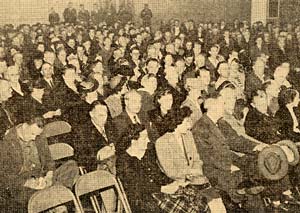 Large groups met in Northwest cities, including Gresham, to demand action against returning Japanese Americans in early 1945. A Bellevue, Washington meeting is shown above. (Folder 22, Box 34, Defense Council Records, OSA)
Large groups met in Northwest cities, including Gresham, to demand action against returning Japanese Americans in early 1945. A Bellevue, Washington meeting is shown above. (Folder 22, Box 34, Defense Council Records, OSA) After enduring long years of internment at relocation centers during most of World War II, Oregon's Japanese Americans suffered further indignities as racist and nativist elements in their old communities tried to prevent their return late in the war and into the postwar period. Many internees heard about hateful intentions of Japanese exclusionists in towns such as Hood River and Gresham and chose to start a new life elsewhere in the West. Others returned to their homes, confronted the prejudice, and rebuilt their lives.
Stirring Racist Sentiments
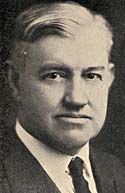 Retiring Oregon U.S. Senator Rufus Holman was outspoken against Japanese Americans. (Oregon Blue Book, Oregon Secretary of State, 1943-1944, Page 13)
Retiring Oregon U.S. Senator Rufus Holman was outspoken against Japanese Americans. (Oregon Blue Book, Oregon Secretary of State, 1943-1944, Page 13) The absence of the interned Japanese Americans from Oregon communities during the war emboldened many opportunistic neighbors and politicians to stir up mistrust and hatred. Newspaper stories were replete with accounts of Japanese military atrocities during the war and therefore provided ample grist for the mill. Many people made a link between their old Japanese American neighbors and the heinous actions of the enemy. Proponents of harsh measures against all people of Japanese descent quoted respected American military leaders to bolster their case. For example, the Oregon-based
Japanese Exclusion League Journal highlighted a statement by Navy Admiral "Bull" Halsey that "Japs are not fit to live in a Civilized World!" along with Army General Douglas MacArthur saying that "the Japanese have proved that they are barbarians."
Footnote
1
Some Oregon political leaders, including retiring U.S. Senator Rufus Holman, jumped on the bandwagon. But none were more consistently anti-Japanese American than former governor and congressman Walter M. Pierce. In the early 1920s, he supported an Oregon law banning ownership of property by Japanese aliens and a federal law barring further immigration of Japanese aliens. If anything, his nativist tendencies deepened over the next two decades. By World War II, he said "we should never be satisfied until every last Jap has been run out of [the] United States and our Constitution changed so they can never get back." Writing in 1945 under the headline "Japs in U.S. Must Go" in the
Japanese Exclusion League Journal, Pierce made his case against Japanese Americans:
Oregon newspaper editors, reflecting public opinion, ran the gamut on issues related to the return of Japanese Americans. Some newspapers echoed statements of the more rabid nativists. For example, the Albany
Democrat-Herald went so far as to question the heroism of Japanese American combat soldiers simply because they had not fought directly against Japanese troops. The Albany newspaper was joined by the Pendleton
East Oregonian in charging that Japanese Americans were plotting to "out-breed" whites in America to gain control. Other editors, in particular former Governor Sprague at the Salem
Statesman, argued forcefully in favor of fair and equal treatment for returning Japanese Americans. Sprague, regretting his role in the internment process of 1942, wrote often and passionately against what he called the "almost insensate prejudice within the white mind." Most editorial writers, however, avoided the subject, perhaps out of fear about getting too far ahead of public sentiment on such a volatile issue.
Footnote
3Conspiracy Theory
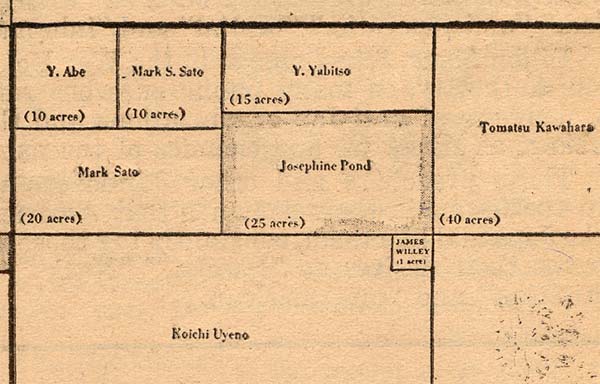 Former Hood River County Clerk Ken Shoemaker claimed Japanese Americans were conspiring to squeeze out white farmers and orchardists in the Hood River Valley. He used the Josephine Pond property as an example. (Folder 22, Box 34, Defense Council Records, OSA)
Enlarge image
Former Hood River County Clerk Ken Shoemaker claimed Japanese Americans were conspiring to squeeze out white farmers and orchardists in the Hood River Valley. He used the Josephine Pond property as an example. (Folder 22, Box 34, Defense Council Records, OSA)
Enlarge image Some advocates of harsh measures pointed to what they claimed to be a long standing conspiracy on the part of the Japanese American community of orchardists in the Hood River Valley. Since the passage of Oregon's 1923 Alien Land Law prohibiting land ownership by Japanese nationals, many purchased land in the names of their children. Former Hood River County Clerk Ken Shoemaker said that his old job of recording deeds had put him "in an excellent position to watch the 'squeeze method' used by the intruding Japs in Hood River Valley as well as other desirable areas where they seek to penetrate...." He charged that Japanese Americans and aliens would systematically purchase property until they had encircled a white landowner. According to Shoemaker, at that point, "needless to say, the bottom has dropped out of the value of what once was excellent property." That land would then be purchased at a low cost and added to the growing Japanese American holdings so "white farmers were gradually being smoked out."
Footnote
4
Along the same lines, the secretary of the Hood River American Legion post wrote to Governor Snell asking for the "assistance of your legal staff" because "there is a widespread beleif [sic] among the people here that this law [Oregon's Alien Land Law] has been cleverly bypassed for many years." Snell, too politically savvy to put his fingerprints on such an issue, offered nothing more than a bland response. Generally, the governor did little to discourage actions of nativists in the state. After intense lobbying, the Legislature passed a law in March 1945 closing loopholes in the 1923 law and adding new penalties.
Footnote
5 Japanese Americans Begin to Return
Various groups sent a number of resolutions and letters to the governor and Legislature after the federal government's Public Proclamation No. 21 of Dec. 17, 1944 ended the exclusion of people of Japanese descent from the Pacific Coast. Tensions rose in several communities such as Gresham, Sherwood, and Forest Grove in anticipation of the returning internees. One public meeting in Gresham drew over 1,000 people demanding that the return migration be prevented. Delegations to the meeting from Multnomah, Clackamas and Hood River counties called for the deportation of aliens and other actions against Japanese Americans. Meanwhile, Harold Barr, with the Clackamas Implement Dealers Association, informed the governor that many businessmen and farmers in the Oregon City area were "genuinely concerned about the return of the Japs to this district at this time." Barr urged strong action by the governor "against letting them infiltrate back now." And he claimed that Snell would "gain in stature" from taking a stand on the issue: "The policy of appeasement and pussy-footing should be an example not to follow."
Footnote
6
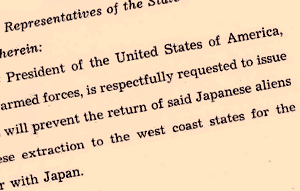 The Oregon House of Representatives and Senate called on President Roosevelt to prevent the return of Japanese Americans to the west coast."House Joint Memorial No. 9" Oregon Legislative Assembly, Feb. 28, 1945. (Oregon History Proje ct)
The Oregon House of Representatives and Senate called on President Roosevelt to prevent the return of Japanese Americans to the west coast."House Joint Memorial No. 9" Oregon Legislative Assembly, Feb. 28, 1945. (Oregon History Proje ct)
The Oregon House of Representatives responded to the political pressure by passing Joint Memorial No. 9 on Feb. 28, 1945. The statement called on President Roosevelt to prevent the return of Japanese Americans "for the duration of the present war with Japan." The legislators based their request on what they described as "considerable antagonism to such return" in Oregon as well as the claim that the internees would be "safer and cause less civilian disturbance in the relocation centers."
Footnote
7
The former internees who did trickle back to their old homes during 1945 were often met with open hostility by white neighbors. Some found their homes looted and their orchards vandalized while others endured boycotts on the purchase of their fruits and vegetables or heard racial slurs or threats. A few were assaulted physically. Some merchants in the Hood River Valley refused to offer service to the returning Japanese Americans. Ralph Sherrieb put a sign in the window of his rural grocery store that read: "PLEASE NOTICE: NO JAP TRADE." Sherrieb said that "we just don't recognize 'em around here." We don't want 'em and we tell 'em to stay away from us. So far as we are concerned, it's once a Jap, always a Jap." The Hood River post of the American Legion called for the "total elimination of all alien Japanese and their sons and daughters of American citizenship from the Hood River area...and 'fair disposal' of property held by these people."
Footnote
8Glare of the National Spotlight
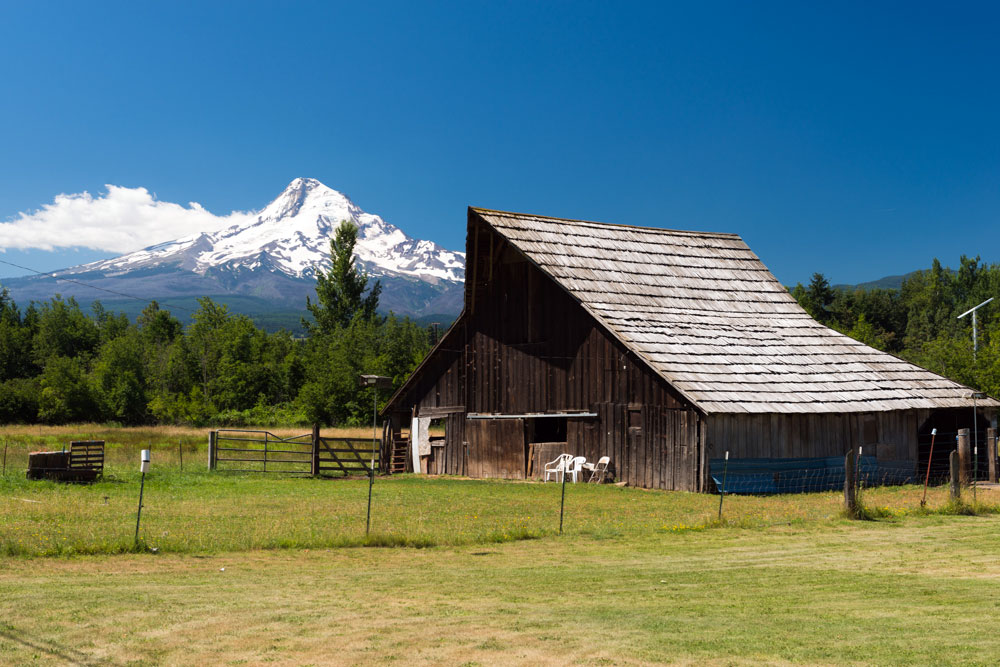 The farms and orchards of Hood River County drew national attention after the local American Legion post removed the names of 16 Japanese Americans from the county's war service honor roll in early 1945. Tensions quickly rose across the county. Get a high resolution copy of this image from the Oregon Scenic Images Collection.
The farms and orchards of Hood River County drew national attention after the local American Legion post removed the names of 16 Japanese Americans from the county's war service honor roll in early 1945. Tensions quickly rose across the county. Get a high resolution copy of this image from the Oregon Scenic Images Collection. Amid escalating hostility, Hood River landed in the national spotlight in January 1945 after the local post of the American Legion removed the names of 16 Japanese American servicemen from a military service honor roll in front of the county courthouse. The action caused a firestorm of indignation and drew the condemnation of magazines and newspapers across the country. A column by New York newspaper writer Thomas L. Stokes focused on the hero's death of Hood River resident Frank T. Hachiya who fell to a sniper's bullet after volunteering for a dangerous mission in the Philippines. Although his name had been omitted from the honor roll in the first place (apparently because he had registered for the draft outside of Hood River), his story epitomized patriotism and sacrifice. Clearly, the removal of the names of other brave Japanese Americans was well beyond what most Americans would tolerate. Yet the local Legion leaders held firm for weeks under increasingly intense pressure to restore the names.
The ongoing controversy caused problems for Governor Snell, not known as a friend of Japanese American rights. Snell and other state officials were concerned about the possibility of violence in the tense war of words. He received a state police officer's report on the "Japanese situation [in] Hood River County" at the end of January 1945. The officer surveyed the sheriff, police chief, district attorney, county judge and others about the possibility of "mob violence in the area." While most discounted large scale violence, one was "afraid there would be scattered cases of fires and assaults." The editor of the local newspaper heard that "certain men...were carrying firearms and had made the statement that they would shoot the first Jap on sight, but due to the fact that he was acquainted with these men, believed this was only a rumor."
Footnote
9
Snell was also concerned with the political fallout of the negative publicity for the state and received advice on what he could do to diffuse the crisis. Hubert Holloway, a New York City public relations expert and former Snell advisor was looking out for Snell's political future when he offered his suggestions:
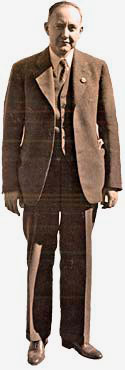 Former Governor Charles Sprague spoke forcefully in support of Japanese American rights. (Photographs, Gov. Sprague Records, OSA)
Former Governor Charles Sprague spoke forcefully in support of Japanese American rights. (Photographs, Gov. Sprague Records, OSA) Snell replied to Holloway that he had discussed the issue several times with the Hood River post commander of the American Legion who maintained that "their position is logical and well founded." The governor relayed that the commander "had stated on several occasions if any branch of the federal government will direct a communication to them which contains a statement that the names of those in question are Japanese loyal to the United States that such names will be reinstated immediately." But while President Harry Truman decried the post's actions, apparently no federal agency had satisfied the Hood River commander's demands. Meanwhile, national American Legion officials, who normally allowed local posts great autonomy, finally gave in to the pressure and embarrassment by instructing the Hood River post to restore the names. The post's leaders, even while submitting to orders, remained defiant, which caused the editors at
The Oregonian to muse that they had "repented under compulsion." The newspaper noted that the Hood River post, "while restoring the names of the nisei service men, utters in the same breath its decision, a continuing resolve, to oppose the return of any Japanese to the Hood river valley."
Footnote
11 Enlightened Actions
But along with the many instances of blatant racism, intimidation, and hatred, some Oregonians welcomed returning Japanese Americans and publicly campaigned in support. Many church leaders and others rallied against anti-Japanese American legislation, calling it "anti-Christian and undemocratic." They argued that "passage of such legislation would serve as a precedent and an invitation to further legislation which might well penalize Americans because they are Christians or because they are not Christians; because they are property owners or simply because they live on the wrong side of the tracks." The campaign peaked in Gresham at a March 16, 1945 meeting that drew about 1,000 supporters. The event featured a speech by former Governor Sprague in which he said that he knew of "not one single act of sabotage or traitorism committed or on record as having been committed by any person of Japanese extraction in the state of Oregon, and to the best of my knowledge I know of none on the entire Pacific Coast."
Footnote
12
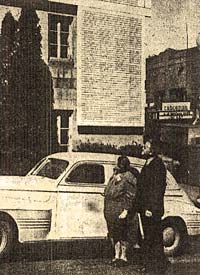 Sherman Burgoyne and Mrs. Max Moore, leaders of the fight to restore the names of Japanese American servicemen, look at the Hood River County honor roll after local American Legion leaders finally relented. (The Oregonian, June 16, 1946, Magazine Section, Page 1)
Sherman Burgoyne and Mrs. Max Moore, leaders of the fight to restore the names of Japanese American servicemen, look at the Hood River County honor roll after local American Legion leaders finally relented. (The Oregonian, June 16, 1946, Magazine Section, Page 1) Meanwhile, others rallied like-minded individuals in Hood River County. The Reverend Sherman Burgoyne worked tirelessly to restore the names of the Japanese American servicemen to the honor roll and to organize support in Hood River for fair treatment. Other citizens formed the League for Liberty and Justice, led by Mrs. Max Moore, a grandmother and operator of an electric shop. Moore said the group organized "because we did not want the country to think that everyone in Hood River approved of the removal of the names from the county courthouse. We wanted America to know that there was tolerance as well as intolerance in Hood River, that many Hood River people believed in fair play. We took the title of our organization from the final words of the pledge of allegiance to the American flag--'with liberty and justice for all.' That's what we stand for."
Footnote
13
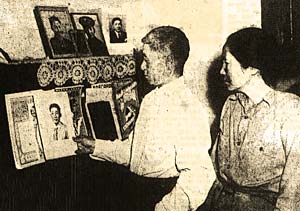 Sagoro Asai and his wife look at photos of their 4 sons who served in the military. The couple spent the war in an internment camp. (The Sunday Oregonian, June 16, 1946, Magazine Section, Page 1)
Sagoro Asai and his wife look at photos of their 4 sons who served in the military. The couple spent the war in an internment camp. (The Sunday Oregonian, June 16, 1946, Magazine Section, Page 1) Many Oregonians resisted the pressure to reject Japanese Americans. Taro Asai experienced the value of good neighbors first hand when he returned home to his 40-acre orchard near Hood River. A staff sergeant in the Army, Asai had read in the Army newspapers about his name being removed from the honor roll. And he certainly was alarmed by letters from home that told about the organized resistance proclaiming "there is no room in Hood River for Japs." So he felt great relief in seeing with his own eyes that his neighbors, Carl Smith and his wife, had taken good care of his fruit trees. Asai later commented that "the Smiths have shown us what the brotherhood of man really means. They watched over our farm while my parents were in the relocation camp and my brothers and I were in the army. They have been the best friends and neighbors anyone could possibly have." Carl Smith returned the compliments in recounting his experience: "The Asais always have been our friends. We helped them out when they were in trouble. It cost us some of our friends. They accused us of being 'Jap lovers.' Of course that was ridiculous. We were only helping neighbors in trouble."
Footnote
14 Patience Rewarded
Only about half of the prewar population of Japanese Americans returned to the Hood River Valley. Those who did return kept a low profile until the hatred fanned by Walter Pierce, Ken Shoemaker, and others dissipated. The end of the war in August 1945 started the slow healing process. While some neighbors, both white and Japanese Americans, refused to let go of their bitterness, most found ways to get along and move forward. Japanese Americans eventually reintegrated with the social and cultural life of the community, returning to stores, schools, and churches. Government responded too. In the late 1940s the federal government reimbursed a small portion of the economic losses suffered by Japanese Americans due to internment. The Oregon Supreme Court struck down the Alien Land Law in 1949. Hundreds of Oregon Issei, those born in Japan, applied for citizenship after Congress lifted the ban in 1952. And in 1965 Congress finally reversed the strict and racist immigration quotas that dated back to the 1920s.
Footnote
15 Related Documents
Notes